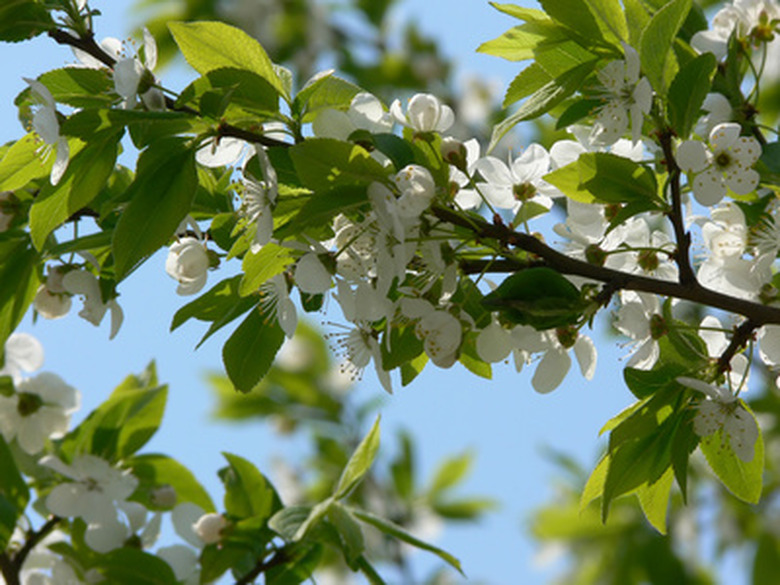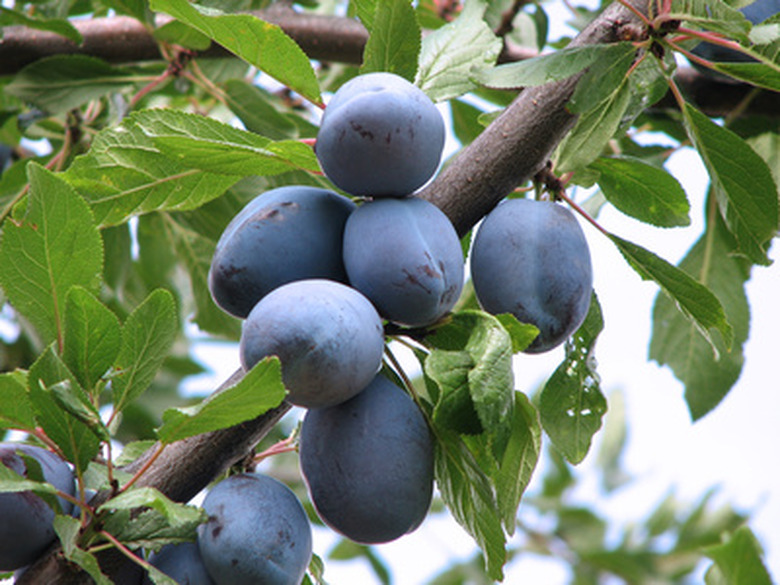How To Identify Different Plum Trees
Plum trees (Prunus spp.) come in a wide range of different species and cultivated varieties, or cultivars. Plum trees are among the cold-hardiest of fruit trees, some species growing in regions with winter temperatures that are well below 0 degrees F. Different types of plum trees can be difficult to tell apart, especially when they aren't fruiting, but you can distinguish the species or cultivar by looking at many other characteristics. About six or seven main plum tree species are the most common throughout the world.
Step 1
Identify the American plum tree (Prunus Americana) by its 10- to 30-foot mature height and 5- to 12-inch trunk diameter. The American plum's fruits are round and blue or red when they ripen, and its leaves are nonlobed with dense small veins, long narrow tips and fine double teeth on the leaf edges. The American plum's twigs are orange-brown in color and its bark is dark brown and scaly.
- come in a wide range of different species and cultivated varieties, or cultivars.
- Plum trees are among the cold-hardiest of fruit trees, some species growing in regions with winter temperatures that are well below 0 degrees F. Different types of plum trees can be difficult to tell apart, especially when they aren't fruiting, but you can distinguish the species or cultivar by looking at many other characteristics.
Step 2
Look for a tree that resembles the American plum to spot the Canada plum tree (P. nigra). Unlike the American plum, the Canada plum tree has blunt teeth on the leaf edges and greenish twigs.
Step 3
Identify the Damson plum tree (P. institia) by its 1-inch-diameter, dark blue or purple fruits with yellow, firm inner flesh that ripen from August through October. The Damson plum has oval to elliptical leaves that are green and sometimes wrinkled on the upper surfaces with pale-colored, softly hairy undersides. This plum tree grows 10 to 20 feet tall and wide with an oval-shaped canopy.
Step 4
Look for medium to large, round or conical fruits with purplish-red skin and red flesh to identify the Methley plum tree (P. salicina). Also growing 10 to 20 feet tall and wide, the Methley plum tree has bright-green leaves and blooms in white umbrella-shaped flower clusters as early as late winter, often remaining on the tree while covered with snow.
- Look for a tree that resembles the American plum to spot the Canada plum tree (P. nigra).
- Identify the Damson plum tree (P. institia) by its 1-inch-diameter, dark blue or purple fruits with yellow, firm inner flesh that ripen from August through October.
Step 5
Spot the Mexican plum tree (P. mexicana) by looking for its small, red fruits and orange autumn leaves. The Mexican plum also blooms in late winter with showy, fragrant white flowers, but this tree grows 15 to 30 feet tall with a rounded canopy that's 20 to 25 feet wide at maturity.
Step 6
Look for distinctive, deep-purple foliage to identify the purpleleaf plum tree (P. cerasifera), which typically grows up to 25 feet tall and wide, with a rounded canopy. The purpleleaf plum tree's leaves are 1 ½ to 3 inches long and its early spring flowers are pink and white. Purpleleaf plum trees produce reddish, 1 ¼-inch-diameter, round fruits in late summer.
Tip
You can also identify different plum trees by noticing where they're growing. The American and Canada plum trees can grow in the coldest regions and cannot tolerate much heat, while the Damson plum tree is hardy down to -15 degrees F and can tolerate a wide range of soil types. The Methley plum is also hardy down to -15 degrees F and can tolerate high heat with a short dormancy period, but prefers lower humidity and rainfall while actively growing. The Mexican plum is hardy down to only -5 degrees F, but it can grow in nearly any soil type and is drought-tolerant when established. The purpleleaf plum withstands temperatures down to -25 degrees F and prefers acidic, well-draining soils, but tolerates some heat and drought.
Warning
Don't confuse the Methley plum tree with the Burbank plum, both of which are derived from the same species. Unlike the Methley variety, the Burbank plum tree can grow up to 35 feet tall and produces red and golden-yellow fruits. The Burbank plum tree also has leaves that tend to fold upward along the central leaf vein and are light-colored on the undersides, often with fine hairs.

